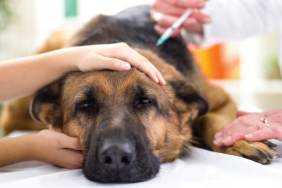Happy National Poison Prevention Week! I know, I know, this is not the most exciting or happy week to celebrate but it might be one of the most important. As reading, understanding, comprehending humans we know what is good and bad for our bodies. We know what is toxic, what will cause damage and make us sick. Our pets, however, rely on our judgement as pet parents to look after what they eat. From food to water to toys, our pets need us to help keep them safe from their inquisitive nature and desire to put everything in their mouths. You know, that pile of junk in the garage that’s oozing some unknown substance (don’t deny it, we all have one) or that tangle of cords behind the TV that is still in reach of the kitty.
Some of these things are common sense like giving chocolate or grapes to your pet but what about the pile in the garage? How often do you think about your pet getting into things around the house? How about the things we willingly give our pets that we might assume are good for them, like peanut butter? In honor of National Poison Prevention Week here is short list of common household items or foods that are severely poisonous to our pets.
- Lilies, Tulips and Daffodils
Lilies, especially Easter, Day, Tiger, Asiatic, Japanese and Show Lilies are all extremely toxic to pets. Consuming even two or three petals can result in kidney failure. Ingestion of any kind can be fatal to your feline. Even walking through fallen pollen and licking paws later is fatally dangerous.

Tulips are major cause for concern for those of you who have pooches who love to dig. Tulip bulbs have a high concentration of toxicity to dogs and can cause tissue irritation, vomiting, excessive drooling or diarrhea.
Daffodils contain toxins in nearly all parts of the plant. The bulb, flower or plant can cause extreme abdominal pain, diarrhea, vomiting, cardiac arrhythmia and even respiratory depression. Ingestion of the crystals on the outer layer of the bulb can trigger further reactions in your pet.
If you even suspect your pet has ingested part of these plants, head immediately to the vet or call the Pet Poison Helpline. Check out a complete list of toxic plants here.
2. Xylitol
This natural sugar sweetener is found in nearly every type of gum, candy, mint, yogurt, ice cream and even some peanut butter. Xylitol has been known to cause hypoglycemia and severe liver damage in dogs. What exactly does that mean? VCA Animal Hospital helped  us out with an easy explanation, “Xylitol is quickly absorbed into the bloodstream, resulting in a potent release of insulin from the pancreas. This rapid release of insulin results in a rapid and profound decrease in the level of blood sugar (hypoglycemia), an effect that occurs within ten -60 minutes of eating the xylitol. Untreated, this hypoglycemia can be life threatening.” As little as five grams (.17 ounces!) can be life threatening. Check out this complete list of foods containing xylitol and be sure to read ingredient labels or consult this list before giving your pet people food!
us out with an easy explanation, “Xylitol is quickly absorbed into the bloodstream, resulting in a potent release of insulin from the pancreas. This rapid release of insulin results in a rapid and profound decrease in the level of blood sugar (hypoglycemia), an effect that occurs within ten -60 minutes of eating the xylitol. Untreated, this hypoglycemia can be life threatening.” As little as five grams (.17 ounces!) can be life threatening. Check out this complete list of foods containing xylitol and be sure to read ingredient labels or consult this list before giving your pet people food!
- Over the Counter Medications
Advil, Aleve, Motrin and Tylenol are four of the most common medications pets can get their paws on. As little as one or two pills can cause intestinal and stomach ulcers and kidney failure. Tylenol is the most toxic according to the Pet Poison Helpline.  “One regular strength tablet of acetaminophen (Tylenol) may cause damage to a cat’s red blood cells, limiting their ability to carry oxygen. In dogs, acetaminophen leads to liver failure and, in larger doses, red blood cell damage.” Toxicity affects from these medications often lasts five to six times longer in cats than dogs because cats do not have the proper proteins in their stomach to breakdown aspirin. Symptoms of poisoning may appear within ten – 30 minutes or be as delayed at 12-24 hours. Symptoms include: vomiting (potentially vomiting blood), diarrhea, dehydration, abdominal pain and pale gums.
“One regular strength tablet of acetaminophen (Tylenol) may cause damage to a cat’s red blood cells, limiting their ability to carry oxygen. In dogs, acetaminophen leads to liver failure and, in larger doses, red blood cell damage.” Toxicity affects from these medications often lasts five to six times longer in cats than dogs because cats do not have the proper proteins in their stomach to breakdown aspirin. Symptoms of poisoning may appear within ten – 30 minutes or be as delayed at 12-24 hours. Symptoms include: vomiting (potentially vomiting blood), diarrhea, dehydration, abdominal pain and pale gums.
If you suspect your pet may have gotten into your medicine cabinet, call the vet or Pet Poison Helpline immediately even if they do not show symptoms right away.
- Pesticides and Herbicides
It is spring time and that means getting those winter lawns looking green again. Killing off unwanted weeds, spraying off bees, mosquitoes and other unwanted pests is common this time of year. However, your beautiful, bug free lawn might come at a  price for your pets. Whether you or a lawn service are caring for your yard, read labels to find out what is and is not appropriate for pets. Dogs and outdoor cats have a tendency to eat grass and dig dirt. When grass has been chemically treated your pet is ingesting those same chemicals. Dog toys that get left in the yard during treatment get coated in toxins too. Dogs and cats often groom themselves and after a romp in the yard, chemicals and toxins stick to their paws and fur, which when grooming, get ingested and can cause damage. If you insist on getting your yard sprayed check out Pesticide Action Network’s Pesticide Database for toxicity and regulatory information.
price for your pets. Whether you or a lawn service are caring for your yard, read labels to find out what is and is not appropriate for pets. Dogs and outdoor cats have a tendency to eat grass and dig dirt. When grass has been chemically treated your pet is ingesting those same chemicals. Dog toys that get left in the yard during treatment get coated in toxins too. Dogs and cats often groom themselves and after a romp in the yard, chemicals and toxins stick to their paws and fur, which when grooming, get ingested and can cause damage. If you insist on getting your yard sprayed check out Pesticide Action Network’s Pesticide Database for toxicity and regulatory information.
Short, simple list right? It is hard to remember how each small thing can impact your pet’s well-being. Sending flowers for a birthday, anniversary or holiday never seemed so complicated before, but it is crucial to look up each plant before sending or receiving flowers into your home to make sure they are not toxic to your pet.
What happens if your dog hops onto the kitchen counter to swipe down that jar of Go Nuts peanut butter because it’s just ‘oh so tempting’?
Signs of poisoning can occur immediately or one day later depending on the amount consumed and which type of poison it is. Good indications that your pet has been poisoned are:
- Vomiting
- Diarrhea
- Excessive salvation
- Difficulty breathing
- Loss of consciousness
- Seizures
- Stumbling as if drunk
- Pale gums
If you notice any of these symptoms or even suspect your pet is poisoned call your vet IMMEDIATELY! They may instruct you to induce vomiting before bringing your pet in. If possible gather vomit or stool sample for your vet, this may help them determine the cause of poison. For this reason, it is critical to keep an unopened, up-to-date bottle of hydrogen peroxide in the house, as this is often used to induce vomiting in poison emergencies. Only administer hydrogen peroxide at the instruction of your vet!
If you cannot reach your vet call the Pet Poison Helpline 855-764-7661 for instructions. There is a $49 fee per phone call but this is nothing compared to saving your pet’s life.








 My team and I were deciding on where to volunteer, there are so many choices, among them The Charlotte Humane Society and Animal Care & Control and ultimately my sitters chose Animal Care & Control and I was thrilled. Animal Control often gets a bad wrap but after spending the day with their team, I can confidently say, they are one of the biggest pet advocates in the city.
My team and I were deciding on where to volunteer, there are so many choices, among them The Charlotte Humane Society and Animal Care & Control and ultimately my sitters chose Animal Care & Control and I was thrilled. Animal Control often gets a bad wrap but after spending the day with their team, I can confidently say, they are one of the biggest pet advocates in the city.
 was leaving, “I would sit in my car and cry in the parking lot for ten minutes after I left. I just felt so bad, how could you not?” Eventually she was able to turn her sad frustration into a positive experience. She has made it her mission to bring as much joy to the dogs she walks during the time she has with them. And what more could you ask for in a volunteer?
was leaving, “I would sit in my car and cry in the parking lot for ten minutes after I left. I just felt so bad, how could you not?” Eventually she was able to turn her sad frustration into a positive experience. She has made it her mission to bring as much joy to the dogs she walks during the time she has with them. And what more could you ask for in a volunteer?
 to become regular, long-term volunteers. We want to continue to help give back to the community in the best way we know how, by loving on and caring for pets in whatever capacity we can.
to become regular, long-term volunteers. We want to continue to help give back to the community in the best way we know how, by loving on and caring for pets in whatever capacity we can.
 us out with an easy explanation, “Xylitol is quickly absorbed into the bloodstream, resulting in a potent release of insulin from the pancreas. This rapid release of insulin results in a rapid and profound decrease in the level of blood sugar (hypoglycemia), an effect that occurs within ten -60 minutes of eating the xylitol. Untreated, this hypoglycemia can be life threatening.” As little as five grams (.17 ounces!) can be life threatening. Check out this
us out with an easy explanation, “Xylitol is quickly absorbed into the bloodstream, resulting in a potent release of insulin from the pancreas. This rapid release of insulin results in a rapid and profound decrease in the level of blood sugar (hypoglycemia), an effect that occurs within ten -60 minutes of eating the xylitol. Untreated, this hypoglycemia can be life threatening.” As little as five grams (.17 ounces!) can be life threatening. Check out this  “One regular strength tablet of acetaminophen (Tylenol) may cause damage to a cat’s red blood cells, limiting their ability to carry oxygen. In dogs, acetaminophen leads to liver failure and, in larger doses, red blood cell damage.” Toxicity affects from these medications often lasts five to six times longer in cats than dogs because cats do not have the proper proteins in their stomach to breakdown aspirin. Symptoms of poisoning may appear within ten – 30 minutes or be as delayed at 12-24 hours. Symptoms include: vomiting (potentially vomiting blood), diarrhea, dehydration, abdominal pain and pale gums.
“One regular strength tablet of acetaminophen (Tylenol) may cause damage to a cat’s red blood cells, limiting their ability to carry oxygen. In dogs, acetaminophen leads to liver failure and, in larger doses, red blood cell damage.” Toxicity affects from these medications often lasts five to six times longer in cats than dogs because cats do not have the proper proteins in their stomach to breakdown aspirin. Symptoms of poisoning may appear within ten – 30 minutes or be as delayed at 12-24 hours. Symptoms include: vomiting (potentially vomiting blood), diarrhea, dehydration, abdominal pain and pale gums. price for your pets. Whether you or a lawn service are caring for your yard, read labels to find out what is and is not appropriate for pets. Dogs and outdoor cats have a tendency to eat grass and dig dirt. When grass has been chemically treated your pet is ingesting those same chemicals. Dog toys that get left in the yard during treatment get coated in toxins too. Dogs and cats often groom themselves and after a romp in the yard, chemicals and toxins stick to their paws and fur, which when grooming, get ingested and can cause damage. If you insist on getting your yard sprayed check out Pesticide Action Network’s
price for your pets. Whether you or a lawn service are caring for your yard, read labels to find out what is and is not appropriate for pets. Dogs and outdoor cats have a tendency to eat grass and dig dirt. When grass has been chemically treated your pet is ingesting those same chemicals. Dog toys that get left in the yard during treatment get coated in toxins too. Dogs and cats often groom themselves and after a romp in the yard, chemicals and toxins stick to their paws and fur, which when grooming, get ingested and can cause damage. If you insist on getting your yard sprayed check out Pesticide Action Network’s